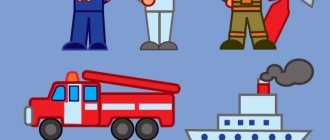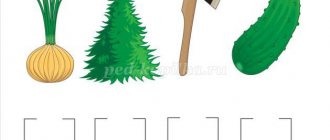Causes
The characteristics of level 2 OHP indicate the polyetiological nature of the speech defect. That is, physical, biological and social prerequisites become the culprit for the development of the disorder. The main provoking factors are:
- fetal hypoxia;
- Rh conflict between mother and child;
- birth asphyxia;
- head injuries received at birth and in the first year of life;
- infections with neurotoxicosis;
- perinatal encephalopathy;
- pedagogical neglect;
- communication deficit;
- heredity
- separation from home, or hospitalism syndrome.
Often, OHP is a consequence of a complex of causes. This is important to consider when diagnosing and correcting a speech defect.
Features of speech development
In order to understand the severity of the defect, it is necessary to analyze its occurrence. A child with ODD will have his own developmental characteristics. He has poor ideas about the world around him and lacks life experience.
The preschooler has difficulty communicating and therefore avoids contact with adults and peers. Interaction with other people is an important tool for learning. Without it, thinking develops poorly.
In his work, a speech therapist not only teaches children to pronounce words correctly, but also to generalize objects and eliminate unnecessary ones. It helps form ideas about the world around us.
If speech development is abnormal, it is necessary to begin by working on its understanding. To do this, children are taught the names of various phenomena, objects, and events. Not only parents, but also educators are involved in this matter.
Over time, a connection appears between the word and the object. Children's auditory perception is poorly developed and therefore needs to be trained. They must be able to distinguish sounds from general noise well by ear.
To successfully overcome OSD, work on all components of speech is necessary. If work starts on time, the prognosis is favorable: more than 80% of children go to regular school.
Speech therapist's lesson on sound production [P]
Speech therapist's lesson on sound production [P]
Some parents, turning to us for help, mistakenly believe that the child needs to correct the letter “r”. In fact, we are talking about the incorrect pronunciation of the sound [P]. What worries many parents most is the incorrect or distorted pronunciation of this sonorant sound.
Disadvantages of sound pronunciation are divided into several groups. Impaired pronunciation of the sounds [P], [P'] is usually referred to as “rotacism”.
Types of impaired sound pronunciation:
- distortions are abnormal pronunciation of sounds that are not found in speech (for example, the throaty pronunciation of the sound [P]);
- substitution - using, instead of a sound that is absent in speech, another sound of the same language - its substitute (for example, “lyba” instead of “fish”, “vaketa” instead of “rocket”);
- omission - absence of sound due to unformed articulatory posture or due to impaired phonemic hearing (for example, “kaova” instead of “cow”)
- confusion - insufficient differentiation of two sounds that are similar in sound or articulation during their pronunciation (“laketa” instead of “rocket”)
Types of distorted pronunciation of sounds [P], [P']:
- interdental - the tongue is thrown out of the mouth, one blow is heard;
- single-impact – with correct articulation of sound, one blow is made on the alveoli with the tip of the tongue;
- proto - correct articulation of sound without vibration, a fricative sound is heard;
- gular - the tip and front part of the back of the tongue are lowered down and pulled back, the back of the back is sharply arched. A strong stream of air causes either the soft palate (velar rhotacism) or the uvula (uvular rhotacism) to vibrate;
- lateral - with correct articulation of sounds, one of the lateral edges of the tongue is lowered, passing a stream of air to the side. It can trap saliva, causing a squelching sound. 1 – 2 beats are heard;
- coachman - lips moved forward. A strong stream of air causes the lips to vibrate;
- nasal - the tip and the front part of the back of the tongue are lowered and pulled back, the back part of the back of the tongue is tense and raised to the soft palate, forming a gap or bow. When bowed, the sound takes on a nasal tint.
Types of sound replacements [P], [P']:
- replacements with any vowel sounds: “yak” instead of “rak”, “iepa” instead of “turnip”;
- replacements with sonorant sounds: “lak” instead of “rak”, “nama” instead of “rama”, “juka” instead of “ruka”, “Lyoma” - instead of “Roma”;
- replacement with labiodentals: “kavova” instead of “cow”;
- replacement with front-lingual ones: “dak” instead of “rak”, “depa” instead of “turnip”;
- replacement with back-lingual ones: “gak” instead of “cancer”, “gepa” instead of “turnip”.
Work on correcting violations of sound pronunciation begins with the development of mobility of the organs of the articulatory apparatus. Articulatory gymnastics helps develop the movements of the organs of the articulatory apparatus.
Articulation gymnastics exercises:
- are selected purposefully;
- are held at the beginning of the lesson;
- fixed at home;
- require 5-7 minutes to complete.
To produce the sounds [P], [P'], you must perform the following articulatory gymnastics exercises:
A basic set of exercises for developing the basic movements and positions of the organs of the articulatory apparatus:
- “Window” - the mouth is wide open, the tongue lies quietly behind the bottom of the oral cavity;
- “Fence” - lips in a smile, the front upper and lower incisors are exposed, standing on top of each other;
- “Tube” - stretching the lips forward in a tube;
- “Shovel” - mouth open, hold a wide tongue on the lower lip in a calm, relaxed state;
- “Needle” - mouth open, hold a narrow tongue between the incisors;
- “Punish the tongue” - knead your tongue with your upper lip, while saying “five-five-five”;
- “Swing” - the mouth is wide open, alternating movements of the tongue up and down and holding each position for five seconds;
- “Clock” - the mouth is slightly open, alternating movements of the tongue to the right and left with fixation for a second in each position;
A set of exercises for developing movements and positions of the organs of the articulatory apparatus when pronouncing the sounds [P], [P']:
- “Mushroom” - development of raising the entire back of the tongue upward, suction of the entire tongue to the upper palate;
- “Delicious jam” - developing the movement of the wide front part of the tongue (lick the upper lip with the wide front edge of the tongue);
- “Let's brush the upper teeth” - developing the lifting and movement of the tongue left and right along the inside of the teeth;
- “Painter” - practicing the movement of the tongue up the hard palate back and forth;
- “Drummer” - strengthening the muscles of the tongue, practicing raising the tongue upward, and the ability to make the tip of the tongue tense;
- “Horse” - strengthening the tongue muscle and developing an upward movement of the tongue, producing tongue clicking.
There are several ways to set the sound [P]. Here is one of the most common:
Setting the sound [P] from the sound [D].
- The child loudly pronounces the sound [D] by pressing the tip of the tongue against the tubercles behind the upper teeth (alveoli); The sound must be pronounced for as long as possible, i.e. The tongue should not be separated from the alveoli for as long as possible.
- When pronouncing the sound [D], the tongue should seem to swell from the air exhaled onto it.
- Next, it is necessary to train the child in such a way that he exhales onto the tongue as strongly as possible, and at that moment the tongue comes off the alveoli and flutters and vibrates from a “gust of wind”;
- As a result of training points 1-3, you should get a combination of sounds d-r-r-r;
- In the future, it is necessary to train the sound [P] in such syllables as dra, dro, dro, dra, and later in words;
- To separate the sound [P] from the sound [D], invite the child to pronounce the sound [D] to himself, and the sound [P] at full strength;
- Fix the sound [P] in the syllables ra, ro, ru, ry.
- Practice the correct pronunciation of the [P] sound in various words, sentences and texts.
If, after doing all the work described above, you were unable to correct the sound [P] in your child, then this may be a reason to seek advice from the speech therapists of the Speech Development Center “Easy to Speak”.
Diagnosis differentiation
The correct formulation of the conclusion allows you to competently structure the work. OHP is easily confused with other disorders. Due to errors in diagnosis, the organization of corrective work suffers.
To accurately assess the condition of a particular preschooler, consultations with several specialists are required. If problems with intelligence are identified (mental retardation or mental retardation), then first aid is provided by an oligophrenopedagogist and only then a speech therapist is required.
If there are problems with speech, a diagnosis of SSD (systemic speech underdevelopment) is made. Such a conclusion requires a special structure of correctional work.
Today, there are about thirty types of autistic disorder and autism itself. With this problem, you can decide that the child refuses to communicate. The key difference from OHP is that with an autistic problem, a preschooler can talk, but does not want to. With this violation, the child will not make contact. If you have problems only with speech, it will do.
In this case, he needs the help of a psychologist and only then a speech therapist. Expert opinion – SNR. With autism, a child will not make contact.
The difference between the two diagnoses is not always visible. The need to clarify the structure of the defect is dictated by the fact that the work will be structured differently.
With hearing impairment, oral speech is seriously affected, since without feedback in the form of “hearing your own and others’ speech,” a passive and active vocabulary is not formed. The problem is not necessarily serious (complete deafness), but even a slight decrease in hearing acuity impairs the perception of sounds.
If you have hearing problems, you need the help of an audiologist or a teacher of the deaf. If necessary, cochlear implantation is performed or a hearing aid is selected. After that, the teacher of the deaf is engaged in the development of oral speech.


